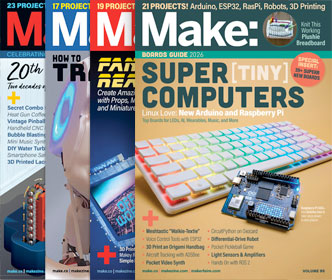

Ever since I assembled my first biped in 2005, I have dreamed of building a full size humanoid robot. Unfortunately, there just aren’t any kits around; it is not that easy to build a stable biped. Even small bipeds suffer problems of stability, processing control, power consumption, and mechanical slop. And as we scale up the size so too do we scale up the stability concerns and the cost.
Today’s typical small bipeds (height range of about 8″ to 18″) cost approximately $400 to $2000. Custom built models for larger sizes — even under 36 inches — can easily hit $30,000. Human-size bipeds typically cost many hundreds of thousands, if not millions of dollars.
I set out to show that it is possible to build a full size biped that can walk for well under $10,000. Is there a low cost, simple way to build a full size biped robot without a huge capital investment and a group of rocket scientists?
Before you doubt, remember that in the 18th century John Harrison, a self-educated maker of wooden clocks, built the first very accurate ship’s chronometer and won a 10,000-pound (that’s old British money) prize. Highly educated scholars of the time refused to acknowledge him because he didn’t have a formal education. Success follows determination and the “Never give up … Never surrender” attitude.
I have been building and rebuilding my big biped for seven years. I call the sixth and most current model WATSON — the Without-a-Tether Stereoscopic Omni-Navigator. All six models were built in my spare time away from my day job as a contract firmware developer. The first prototype, Model 1, was only of a foot, ankle, and thigh. It was a platform to test my theories of biped control.

This model was so successful I decided to build the complete robot.
Model 2 made some changes from the traditional bipeds that are seen on the market today.
Gone:
- Big, flat, square feet
- Heavy servos for foot and ankle movements
- One central control unit running the whole robot
Added:
- Human foot style with three points of contact
- Linkage from the upper leg to control foot position
- One limb processing board controller for each limb
There are many different theories and models used to control bipeds. Some are extremely sophisticated and require complex mathematics to control the dynamic forces we take for granted when we walk. This is NOT about that. There will be some control theory presented, but I will keep it to a minimum. The gist of the theory is that with good enough sensors we can build a large walking robot based on the principle of center of mass.
The design for Model 2 was to create a robot with strong thighs and light feet. It was hoped that this design could evolve in time into a running biped. To achieve this, some of the “cheats” commonly seen in smaller bipeds were designed out, including the huge, square feet.
It’s hard to fall over when you’re wearing cement overshoes. A lower center of mass gives higher stability for a standing robot, but requires a great deal of energy to move each foot. Humans have a high center of mass; when we walk, we throw our weight outside our center of mass and catch ourselves with the other foot, then bound out again on the next step. These fast movements employ an inverted pendulum where the mass is above the pivot point (the ankle).

Every biped needs some sense of balance. Models 1 through 6 (except for Model 5, I’ll get to that) use highly accurate load cells sensing weight at three points per foot. These particular load cells are about 0.2 percent accurate over full scale (up to 100 pounds). They can supply a new reading up to once every millisecond. The cells are mounted on the bottom of the foot as contact points in a triangular layout similar to the human foot.
The human foot has 11 points that distribute the weight, but three are extremely critical; the heel, the ball of the first metatarsal at the big toe, and the fifth metatarsal at the pinkie toe form a tripod. There may be better designs for robotic walking, but with this one I can relate to the forces and feedback the biped experiences.
The goal is to have the foot always support the load within the center of mass, which is the average of the three weights each scaled by the physical distance from the center of mass. When all three sensors of a given foot have some weight, and the total weight is at least 1 pound, then it is possible to determine the current center of mass and how far away from the true center it is in both X and Y directions. This error is fed into a proportional integral loop, which self adjusts the servos, maintaining the center of mass within the triangle.

Two years ago I heard about the DARPA Robotics Challenge. This was just the impetus I needed to continue work on the biped. I was on the fourth rebuild and my goals changed — I now needed to complete several difficult tasks that were not part of my initial design goals:
- Drive a small golf cart
- Climb a ladder
- Open a door
- Turn a valve
- Use a power tool
- Clear heavy debris
I recruited some other enthusiasts to help get ready for the challenge by December 2013. The Model 4 platform was not strong enough to handle the tasks — bigger, more powerful servos were required. We had entered DARPA’s Track D challenge, for teams that do not have government funding. We had no funding at all, so we were not going to use the $2,500 servos or the $1.2 million Atlas robots developed by Boston Dynamics.
I found some $200 servos with huge torque from a U.S. company called Invenscience. They are a bit heavy, but very beefy. I used a month of vacation time and created Model 5, the first to be called WATSON. This was a tease on the very expensive Atlas, which needs a fork lift to carry its power supply behind it via a tether. Model 5 did not use load cells, but could walk using a series of static frames. This was an attempt to get to the DARPA Robotics Challenge in 2013, but we ran out of time to finish the upper body. Without decent working arms, we would not pass the tests. Nevertheless, DARPA invited us back to participate in the challenge in 2014.

The next goal is our auto-balanced walk. With Model 6, the feet have been redesigned back to the center of mass algorithm. Our animation program is working and we are using some of the Robot Operating System toolset for telemetry logging and debugging. We are starting with small steps and working up to bigger and faster gaits.
It has taken seven years of dedication to create a full size walking robot. The first five were the hardest, mostly because I was building it by myself. Now, with the help of Chris Mayer and Girts Linde, we are making big strides (pun intended) in competing with the guys that have all the big bucks. We are pushing hard to be ready for the DARPA Robotics Challenge 2014.
4 thoughts on “I Built a Robot in my Garage to Compete in the DARPA Robotics Challenge”
Comments are closed.
ADVERTISEMENT
Join Make: Community Today










[…] Read more on MAKE […]
[…] I Built a Robot in my Garage to Compete in the DARPA Robotics Challenge […]